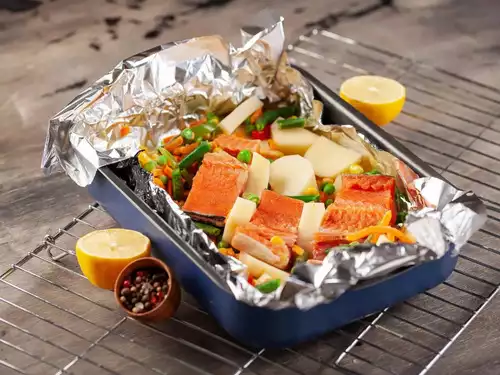The Science Behind Using Aluminum Foil to Wrap Your Food: Benefits and Safety Explained
Have you ever wondered about the magic behind using aluminum foil to wrap your food? Not only is it a convenient way to store leftovers and pack lunches, but there’s actual science behind its benefits and safety. In this insightful article, we delve into the fascinating world of aluminum foil and uncover how it can enhance the freshness and flavor of your favorite dishes.
From keeping your grilled veggies juicy to locking in the moisture of your roasted meats, aluminum foil has been a trusted kitchen companion for decades. But what about health concerns and safety precautions? We’ll break down the facts and myths surrounding the use of aluminum foil for food storage and preparation, giving you the knowledge to make informed choices for you and your family.
Join us on a journey through the science-backed benefits and safety measures of using aluminum foil in your kitchen. Let’s unwrap the secrets together!
Understanding the science behind aluminum foil
Aluminum foil, a ubiquitous kitchen staple, is made from aluminum that has been rolled into extremely thin sheets. The process of creating aluminum foil involves a series of steps, including melting aluminum ingots, rolling them out, and then cutting them into manageable sizes. Its thinness is what makes aluminum foil so versatile, allowing it to conform to various shapes while offering a barrier against moisture, light, and air. This unique structure plays a pivotal role in the foil’s ability to preserve food freshness and flavor.
One of the primary scientific principles at play with aluminum foil is its reflective properties. The shiny side of the foil reflects heat, which can help in cooking processes. For instance, when wrapping food that is being grilled or roasted, the shiny side should be facing inward to reflect heat back onto the food, promoting even cooking. This characteristic not only enhances cooking efficiency but also aids in retaining moisture by providing an insulating layer around the food, thus preventing it from drying out.
Moreover, aluminum foil is non-porous, which means it does not allow air or moisture to penetrate. This property is essential when it comes to food preservation. By wrapping food tightly in aluminum foil, you can significantly reduce the rate of oxidation and moisture loss, which can lead to spoilage. The science behind this barrier effect is crucial for maintaining the quality of perishable items, making aluminum foil an excellent choice for food storage and preparation.
Benefits of using aluminum foil for food wrapping
One of the most significant benefits of using aluminum foil for food wrapping is its ability to preserve freshness. When you wrap food tightly in foil, you create a seal that helps to lock in moisture and flavor. This is particularly beneficial for items like meats, vegetables, and baked goods, as it prevents them from drying out. The moisture retention achieved through aluminum foil wrapping can keep your leftovers tasting as good as when they were first cooked, extending their shelf life and reducing food waste.
Aluminum foil is also incredibly versatile in the kitchen. It can be used for baking, grilling, and even as a makeshift cooking vessel. For instance, when grilling vegetables, wrapping them in foil allows for even cooking while maintaining their natural juices. This technique not only enhances the flavor but also helps to preserve essential nutrients that might otherwise be lost during cooking. Furthermore, aluminum foil can be molded into different shapes, making it ideal for creating packets for steam cooking or roasting.
In addition to its moisture retention and versatility, aluminum foil is lightweight and easy to handle, which makes it an ideal option for packing lunches or snacks. Its flexibility allows you to wrap food securely without the need for additional containers. This is particularly useful for on-the-go meals or picnics, as it minimizes cleanup and reduces the number of dishes used. Overall, the benefits of using aluminum foil for food wrapping contribute to a more efficient and enjoyable cooking and dining experience.
Safety considerations when using aluminum foil
While aluminum foil offers numerous advantages, it is essential to consider safety precautions when using it in the kitchen. One of the primary concerns regarding aluminum foil is its potential to leach aluminum into food, especially when cooking acidic or salty dishes. Studies have shown that aluminum can migrate into food when it is cooked or stored in foil for extended periods, which raises questions about its long-term health effects. To minimize this risk, it is advisable to avoid using aluminum foil with acidic foods such as tomatoes or citrus fruits, as these can increase the leaching process.
Another safety consideration is the proper use of aluminum foil in cooking. When using foil in the oven, ensure that it does not come into direct contact with heating elements or flames, as this can lead to melting or burning. Additionally, if you are using aluminum foil to cover dishes in the oven, make sure that you leave space for steam to escape. This is crucial for preventing a buildup of pressure that could cause the foil to burst, resulting in a messy situation and potential injury.
Lastly, it is important to store aluminum foil correctly. Keep it in a dry place away from moisture, as exposure to humidity can cause it to deteriorate over time. When using aluminum foil for food storage, ensure that it is tightly sealed to prevent any air exposure. By following these safety considerations, you can enjoy the benefits of aluminum foil while minimizing potential health risks.
Myth-busting: Common misconceptions about aluminum foil
There are several myths surrounding the use of aluminum foil in cooking and food storage that can lead to confusion among consumers. One common misconception is that aluminum foil is harmful to health and should be avoided altogether. While it is true that excessive exposure to aluminum may pose health risks, the amounts leached from using aluminum foil in cooking are generally considered to be safe for the average person. The key is to use it wisely and avoid cooking acidic foods in aluminum foil, which can increase leaching.
Another myth is that using aluminum foil in the microwave is safe. While some types of aluminum foil can be used in the microwave, it is crucial to follow specific guidelines. Wrapping food in foil can create sparks and potentially start a fire if the foil comes into contact with the microwave’s walls or heating elements. Therefore, it is advisable to use microwave-safe containers instead of aluminum foil when heating food in the microwave.
Additionally, many people believe that aluminum foil is not recyclable and contributes significantly to environmental waste. In reality, aluminum foil is recyclable, and recycling programs exist in many communities. When properly cleaned and sorted, aluminum foil can be melted down and reused to create new aluminum products. By dispelling these myths and understanding the facts, consumers can make informed choices about their use of aluminum foil in the kitchen.
Alternative uses for aluminum foil beyond food wrapping
Aluminum foil is not just a kitchen tool; it has a variety of alternative uses that can be incredibly helpful around the house. One practical application is in cleaning. Crumpling a sheet of aluminum foil into a ball can create an effective scrubbing tool for pots and pans. It can help remove stubborn burnt-on food without scratching the surface, making it a handy addition to your cleaning arsenal. This technique is particularly useful for stainless steel cookware, where aluminum foil can restore shine while being gentle on the material.
Another innovative use for aluminum foil is in gardening. Gardeners often use aluminum foil to create reflective surfaces in their gardens, which can help to enhance sunlight exposure for plants. By placing foil around plants or in the garden beds, you can reflect light back onto the plants, promoting healthier growth and potentially increasing yields. Additionally, aluminum foil can be used to create barriers against pests; wrapping the bases of young plants with foil can deter insects and prevent them from reaching the vulnerable stems.
Aluminum foil can also serve as a creative tool for arts and crafts. Its malleability allows for easy shaping into various forms, making it a popular choice for DIY projects. Whether you’re crafting sculptures, making ornaments, or creating decorative pieces, aluminum foil is an affordable and versatile material that can spark creativity. These alternative uses highlight the multifunctionality of aluminum foil, making it a valuable item to have on hand beyond just food wrapping.
Environmental impact of using aluminum foil
The environmental impact of aluminum foil is a topic that has garnered attention in recent years. On one hand, aluminum foil is a recyclable material, which can help reduce waste when disposed of correctly. The recycling process for aluminum is efficient; it requires only about 5% of the energy needed to produce new aluminum from raw materials. This means that when consumers recycle aluminum foil, they contribute to a more sustainable cycle, helping to conserve natural resources and reduce landfill waste.
However, the production of aluminum foil does have significant environmental implications. The mining of bauxite, the primary source of aluminum, can lead to deforestation, habitat destruction, and pollution. Additionally, the refining process consumes large amounts of energy, which often comes from non-renewable sources. As a result, the carbon footprint associated with aluminum production is a concern for environmentalists. To mitigate these impacts, it is essential for consumers to recycle aluminum foil and choose products made from recycled materials whenever possible.
Furthermore, consumers can reduce the environmental impact of aluminum foil by using it judiciously. Instead of using foil for single-use applications, consider alternatives like reusable containers or beeswax wraps for food storage. By making informed choices and utilizing aluminum foil responsibly, individuals can enjoy its benefits while minimizing their ecological footprint.
Tips for using aluminum foil effectively in the kitchen
To maximize the benefits of aluminum foil in your kitchen, there are several tips and techniques to consider. First, when wrapping food, ensure that you use enough foil to create a tight seal. This helps to lock in moisture and flavor, ultimately preserving the quality of the food. For larger items like whole chickens or roasts, consider double-wrapping them to provide extra insulation and protection during cooking or storage.
When using aluminum foil for baking, it’s important to remember that the shiny side reflects heat while the dull side absorbs it. For optimal results, place the shiny side facing outwards when lining baking sheets or pans. This will help to achieve even browning and cooking. Additionally, when covering dishes in the oven, leave a small gap or vent to allow steam to escape, which helps prevent sogginess.
Finally, consider reusing aluminum foil when possible. After cooking, if the foil is still clean and intact, you can wash it and set it aside for future use. This practice not only saves money but also reduces waste, aligning with more sustainable kitchen habits. By implementing these tips, you can make aluminum foil a more effective tool in your culinary endeavors.
How to store and recycle aluminum foil
Proper storage of aluminum foil is essential for maintaining its quality and usability. To store aluminum foil, keep it in a cool, dry place away from moisture and heat. Excessive humidity can cause the foil to lose its integrity and become less effective for wrapping food. Additionally, avoid exposing the foil to direct sunlight, as this can weaken its structure over time. When storing unopened rolls, ensure that the roll is kept in its original packaging for optimal protection.
Recycling aluminum foil is a straightforward process, but it requires some preparation to ensure it is accepted by recycling facilities. Before recycling, make sure to clean the foil thoroughly to remove any food residue. Contaminated foil can often be rejected by recycling programs, so rinsing it off before disposal is crucial. Once clean, you can either crush the foil into a ball or flatten it out, depending on your local recycling guidelines.
To recycle aluminum foil, check with your local municipality to see if they accept it in curbside recycling programs. If curbside recycling is not an option, many grocery stores offer drop-off locations for aluminum products. By following these storage and recycling practices, you can ensure that your use of aluminum foil is both efficient and environmentally responsible.
Comparing aluminum foil to other food wrapping materials
When it comes to food wrapping materials, aluminum foil is often compared to alternatives like plastic wrap, wax paper, and parchment paper. Each of these materials has its unique properties and benefits, making them suitable for different applications. For instance, plastic wrap is excellent for sealing containers and keeping moisture in, but it is not as effective at withstanding high temperatures during cooking. In contrast, aluminum foil can safely be used in the oven and on the grill, making it a more versatile option for cooking methods.
Wax paper is another alternative that is commonly used for food storage. While it provides a moisture barrier, it is not heat-resistant and should never be used in the oven. This limitation makes aluminum foil a superior choice for tasks that involve cooking or baking, as it can withstand higher temperatures without melting or degrading. Parchment paper, on the other hand, is ideal for lining baking sheets and preventing sticking during cooking but does not offer the same level of protection against air and moisture as aluminum foil does.
Ultimately, the choice between aluminum foil and other wrapping materials depends on the specific needs of the task at hand. For cooking and food preservation, aluminum foil remains a top contender due to its versatility, heat resistance, and effective moisture retention. Understanding the strengths and weaknesses of each material can help consumers make informed decisions based on their culinary requirements.
Conclusion: Making informed choices about using aluminum foil
In conclusion, aluminum foil is a remarkable kitchen tool that offers a range of benefits for food wrapping, cooking, and preservation. Its unique properties, such as moisture retention and heat reflection, make it an invaluable asset for enhancing the quality of meals and extending the shelf life of leftovers. However, it is equally important to consider safety measures and environmental impacts when using aluminum foil.
By understanding the science behind aluminum foil, debunking common myths, and exploring alternative uses, consumers can make informed choices that align with their culinary practices and values. Utilizing aluminum foil responsibly, along with proper storage and recycling methods, can contribute to a more sustainable kitchen environment.
As you continue to enjoy the convenience and versatility of aluminum foil, remember to balance its benefits with safety considerations and environmental awareness. With this knowledge in hand, you can confidently embrace aluminum foil as an essential part of your cooking and food storage routine, ensuring delicious meals and minimized waste for you and your family.



